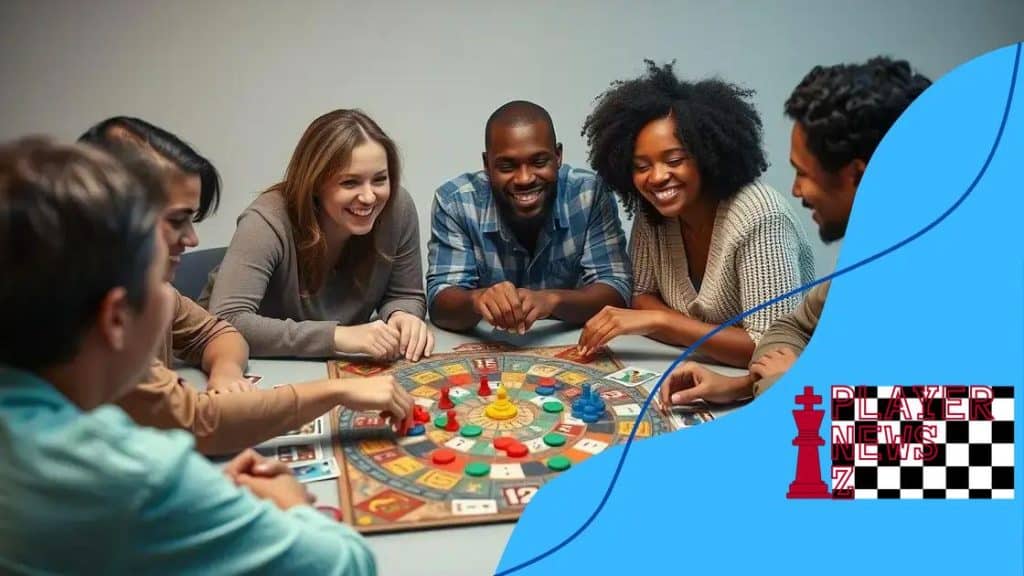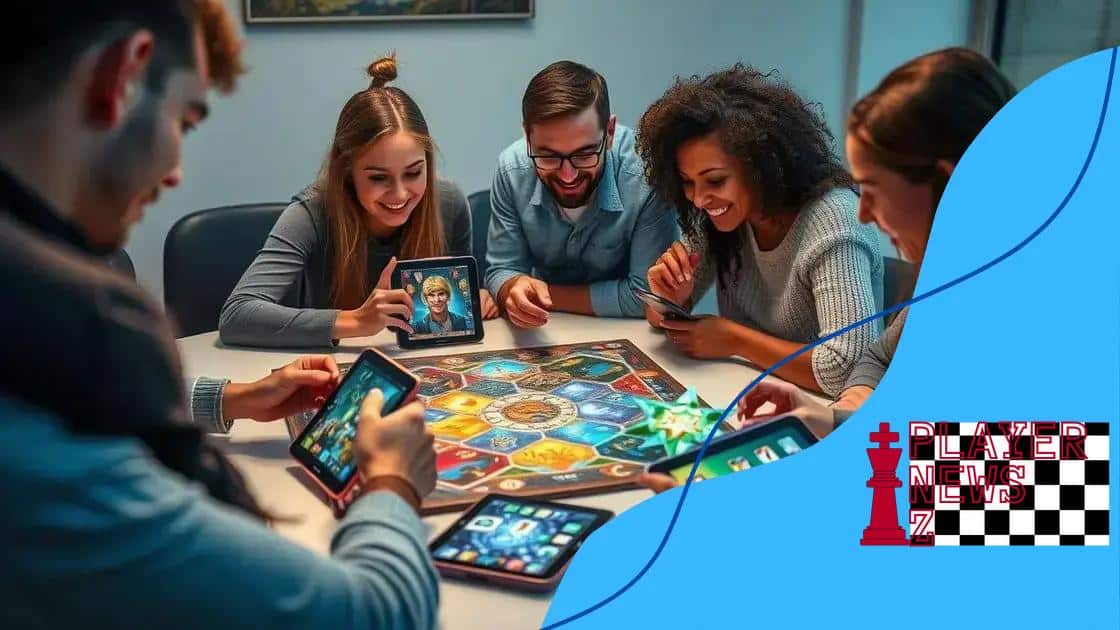Game design trends in the board gaming industry

Sustainability trends in game production emphasize the use of eco-friendly materials, green manufacturing processes, and community engagement to reduce environmental impact and enhance player satisfaction.
Game design trends in the board gaming industry are evolving rapidly, captivating players with fresh ideas and unique mechanics. Have you noticed how certain themes and styles come and go? Let’s dive into the latest trends shaping today’s board games.
Emerging themes in board game mechanics
Emerging themes in board game mechanics are shaping the gaming landscape in exciting ways. As games evolve, designers are exploring new concepts that enhance engagement and strategy.
Collaborative Gameplay
One prominent theme is collaborative gameplay. This approach encourages players to work together, fostering teamwork and communication. By combining strengths, players navigate challenges more effectively.
- Increased social interaction.
- Shared goals lead to deeper connections.
- Encourages strategic thinking as a group.
This trend brings a sense of unity, making the gameplay experience more meaningful.
Asymmetrical Design
Another emerging theme is asymmetrical design. In these games, players have different roles, abilities, or objectives. This creates a varied experience and keeps players engaged.
For example, in some games, one player might be a powerful villain, while others are heroes trying to thwart their plans. This setup requires unique strategies and adds depth to gameplay.
- Each player enjoys a unique experience.
- Encourages creativity in strategy.
- Heightens the sense of competition.
Asymmetrical mechanics also promote replayability, as each session can feel fresh with different roles at play.
Legacy Mechanics
Legacy mechanics are transforming how games are played over time. These games evolve as players make ongoing decisions that affect future gameplay. This long-term investment in a game adds a personal touch.
Players often find themselves attached to the story and characters, making each game session feel like a continuation rather than a reset.
- Promotes ongoing player investment.
- Engages players in storytelling.
- Creates a unique history for each game group.
Legacy games offer a dynamic approach, ensuring players’ choices lead to lasting change.
The role of storytelling in game design
The role of storytelling in game design has become increasingly important. A strong narrative can enhance the player’s experience and create a lasting connection with the game.
Engagement Through Narrative
Players are more engaged when they can immerse themselves in a story. Games with a well-developed plot encourage players to explore the world. They invest their time and emotions in the characters.
- Players feel more connected to the game’s outcome.
- Stories trigger emotional responses that enhance gameplay.
- Strong narratives can lead to memorable experiences.
This emotional investment drives players to replay the game just to relive the story.
Character Development
Another aspect is character development. Well-crafted characters with depth can make a game more relatable. Players often form bonds with characters that grow over time.
Developing backstories enriches the gameplay experience. These characters face challenges, which the players help overcome, creating a sense of accomplishment.
- Allows players to embody their characters.
- Encourages personal investment in the game.
- Varied character arcs make each playthrough unique.
This dynamic promotes replayability and a unique relationship with the game’s universe.
World-Building
A detailed world also contributes to storytelling. Game designers craft immersive environments that enhance narratives and gameplay. Players can explore rich landscapes and cultures, making the game feel alive.
This world-building connects the gameplay with the overall story. Players discover hidden lore and secrets that deepen their understanding of the game.
- Encourages exploration and curiosity.
- Immersive worlds can lead to emotional journeys.
- A cohesive setting enhances the narrative experience.
Ultimately, when players engage fully with the story, they form a stronger bond with the game itself.
How technology influences board gaming

How technology influences board gaming is a significant topic in today’s gaming landscape. With advancements in tech, board games are evolving, offering exciting new experiences for players.
Digital Integration
One major influence is the integration of digital components in traditional board games. Many games now use apps, making gameplay more interactive. These apps can track scores, provide tutorials, or even serve as game masters.
- Enhances gameplay with real-time updates.
- Makes complex rules easier to understand.
- Offers unique game experiences through interactive elements.
This fusion of digital and physical play can attract a wider audience, revisiting classic games with a modern twist.
Smart Devices
Another impact comes from the use of smart devices. Games can connect via Bluetooth or Wi-Fi, allowing for enhanced game mechanics and communication between devices. This connectivity leads to more engaging and dynamic gameplay.
For instance, some games allow players to customize character stats in real-time or unlock additional content through their devices.
- Encourages collaboration among players.
- Brings new strategies to the table.
- Provides updates and expansions without physical components.
As more players own smart devices, this trend continues to grow, merging digital advantages with traditional gameplay.
Game Design Software
Technology has also impacted how board games are designed. Game designers now use advanced software to develop, prototype, and test games efficiently. These tools help to create balanced mechanics and refine gameplay.
Prototyping software can simulate various playthroughs, allowing designers to identify issues early in the design phase. This leads to more polished final products, ultimately benefiting players.
- Facilitates quick iteration and testing.
- Provides valuable data on player interactions.
- Enhances creativity in game development.
The combination of technology and traditional gameplay transforms how games are created and enjoyed.
The impact of player feedback on design
The impact of player feedback on design is crucial in the board gaming industry. Designers increasingly rely on insights from players to improve their games.
Enhancing Gameplay Through Feedback
One of the main ways player feedback influences design is by enhancing gameplay. When players share their experiences, designers gain valuable information on what works and what doesn’t. This feedback can lead to changes that make the game more enjoyable.
- Identifies confusing rules or mechanics.
- Highlights elements that players love or dislike.
- Guides improvements for balance and pacing.
As designers incorporate this feedback, games often become more engaging, leading to better player satisfaction.
Playtesting and Iteration
An essential part of the design process is playtesting, which heavily involves receiving player feedback. During testing sessions, players provide immediate reactions to new mechanics. This information is vital to iterate on designs and refine gameplay.
Designers may conduct several rounds of playtesting, making adjustments based on observations and player comments. This iterative process ensures that the final product resonates with the target audience.
- Facilitates rapid adjustments to game mechanics.
- Encourages experimentation with new ideas.
- Builds a community around the game prior to release.
Through continuous feedback, games evolve and adapt, resulting in a polished experience for players.
Building a Community
Player feedback also helps build an engaged community. When players feel their opinions matter, they become more invested in the game. Communities formed around feedback foster loyalty and word-of-mouth marketing.
Designers often involve players in discussions through social media or forums, creating a dialogue that further enhances game development.
- Encourages players to share their experiences.
- Creates opportunities for collaboration with designers.
- Leads to fan-driven content and ideas.
This two-way communication nurtures enthusiasm and excitement within the gaming community.
Sustainability trends in game production
Sustainability trends in game production are becoming vital as creators seek to reduce their environmental impact. As awareness grows, the board gaming community is increasingly embracing eco-friendly practices.
Eco-Friendly Materials
One major trend is the use of eco-friendly materials in game production. Many designers are now prioritizing sustainable resources, such as recycled cardboard and biodegradable components. This shift not only benefits the environment but also resonates with eco-conscious players.
- Reduces waste and environmental footprint.
- Supports responsible sourcing of materials.
- Increases consumer loyalty among environmentally-minded players.
By choosing these materials, companies can make a positive statement about their commitment to sustainability.
Green Manufacturing Processes
In addition to materials, manufacturers are adopting green manufacturing processes. These processes focus on reducing energy consumption and minimizing waste during production.
By implementing cleaner technologies and facilities, producers are lessening their impact on the planet. This change can result in cost savings as well, which may be passed on to consumers.
- Decreases carbon footprint associated with production.
- Increases efficiency and reduces costs.
- Attracts partnerships with other eco-conscious brands.
Consumers are more likely to support brands that prioritize sustainability over traditional practices.
Community Engagement and Education
Another crucial aspect of sustainability trends involves community engagement and education. Game companies are taking steps to educate players about sustainable practices. Workshops, social media campaigns, and events help spread awareness about the importance of sustainability in gaming.
By involving the community, companies not only enhance their brand image but also foster a culture of responsibility among players.
- Empowers players to make informed choices.
- Builds connections with customers through shared values.
- Encourages participation in environmental causes.
As players become more informed, they will likely demand even more sustainable practices in the products they purchase.
FAQ – Frequently Asked Questions about Sustainability Trends in Game Production
What materials are considered eco-friendly in game production?
Eco-friendly materials include recycled cardboard, biodegradable components, and sustainable wood sources that reduce environmental impact.
How do green manufacturing processes benefit board game production?
Green manufacturing processes help to reduce energy consumption and waste, leading to cost savings and a lower carbon footprint.
Why is community engagement important for sustainable practices?
Community engagement raises awareness about sustainability and encourages players to participate in environmentally-friendly initiatives.
What is the impact of player feedback on sustaining eco-friendly practices?
Player feedback provides valuable insights that can help designers improve their sustainable practices and increase player satisfaction.





